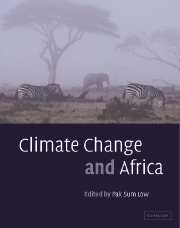Book contents
- Frontmatter
- Contents
- Notes on contributors
- Peer reviewers
- Editor's note
- Foreword
- Foreword
- Foreword
- Foreword
- Preface
- Preface
- Preface
- Preface
- List of abbreviations
- List of SI prefixes
- List of unit abbreviations
- List of chemical formulae
- Part I Science
- 1 Holocene climatic, hydrological and environmental oscillations in the tropics with special reference to Africa
- 2 The relative importance of the different forcings on the environment in Ethiopia during the Holocene
- 3 Global warming and African climate change: a reassessment
- 4 Interactions of desertification and climate in Africa
- 5 Africa's climate observed: perspectives on monitoring and management of floods, drought and desertification
- 6 Atmospheric chemistry in the tropics
- 7 Natural and human-induced biomass burning in Africa: an important source for volatile organic compounds in the troposphere
- 8 Biomass burning in Africa: role in atmospheric change and opportunities for emission mitigation
- 9 Soil micro-organisms as controllers of trace gas emissions over southern Africa
- Part II Sustainable energy development, mitigation and policy
- Part III Vulnerability and adaptation
- Part IV Capacity-building
- Part V Lessons from the Montreal Protocol
- Index
6 - Atmospheric chemistry in the tropics
Published online by Cambridge University Press: 10 December 2009
- Frontmatter
- Contents
- Notes on contributors
- Peer reviewers
- Editor's note
- Foreword
- Foreword
- Foreword
- Foreword
- Preface
- Preface
- Preface
- Preface
- List of abbreviations
- List of SI prefixes
- List of unit abbreviations
- List of chemical formulae
- Part I Science
- 1 Holocene climatic, hydrological and environmental oscillations in the tropics with special reference to Africa
- 2 The relative importance of the different forcings on the environment in Ethiopia during the Holocene
- 3 Global warming and African climate change: a reassessment
- 4 Interactions of desertification and climate in Africa
- 5 Africa's climate observed: perspectives on monitoring and management of floods, drought and desertification
- 6 Atmospheric chemistry in the tropics
- 7 Natural and human-induced biomass burning in Africa: an important source for volatile organic compounds in the troposphere
- 8 Biomass burning in Africa: role in atmospheric change and opportunities for emission mitigation
- 9 Soil micro-organisms as controllers of trace gas emissions over southern Africa
- Part II Sustainable energy development, mitigation and policy
- Part III Vulnerability and adaptation
- Part IV Capacity-building
- Part V Lessons from the Montreal Protocol
- Index
Summary
Keywords
Atmospheric chemistry; ozone; tropics
Abstarct
This chapter presents an overview of the chemical processes that determine the budget of tropospheric ozone (O3) and the formation of the hydroxyl radical (OH), with emphasis on their role in the tropics. These chemical species contribute to the oxidizing power of the atmosphere, which determines the lifetime of many chemical pollutants and several greenhouse gases. Tropospheric O3 and OH are directly affected by chemical species, including water vapour, carbon monoxide, methane, non-methane hydrocarbons and nitrogen oxides. The emissions of these gases by natural and anthropogenic processes are not sufficiently well quantified to provide accurate estimates of the O3 and OH budgets. Field campaigns such as the EXPRESSO campaign in central Africa have attempted to improve our quantitative understanding of tropical emissions on the continents. Models will be used to assess the role of isoprene emissions by vegetation, carbon monoxide and nitrogen oxides by large-scale tropical fires and production of nitrogen oxides by lightning activity, which is most intense in tropical thunderstorms.
INTRODUCTION
Many of the human-induced perturbations in the Earth system involve changes in the chemical composition of the atmosphere. For example, the atmospheric concentrations of carbon monoxide (CO), nitrogen oxides (NOx), and tropospheric ozone (O3) have increased in response to fossil fuel consumption, mostly at mid-latitudes in the northern hemisphere, and to biomass burning, mostly in the tropics.
- Type
- Chapter
- Information
- Climate Change and Africa , pp. 60 - 68Publisher: Cambridge University PressPrint publication year: 2005



